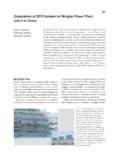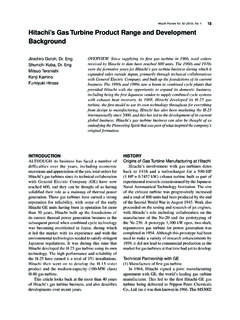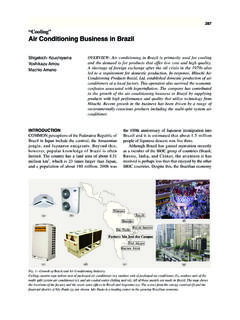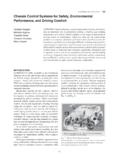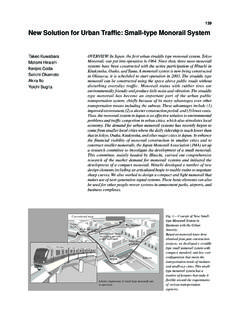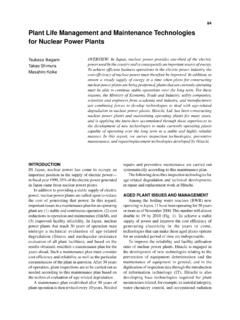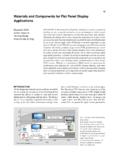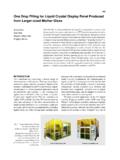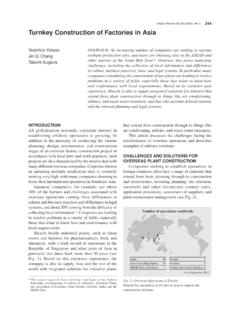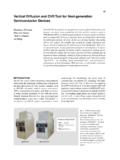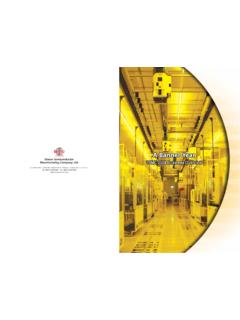Transcription of Semiconductor Inspection System for Next …
1 Semiconductor Inspection System for next - generation 216 Semiconductor Inspection System for next -generationOVERVIEW: The miniaturization of Semiconductor devices is acceleratingyear by year, as represented by the technical roadmap of ITRIS (InternationalTechnology Roadmap for semiconductors ). Along with this trend, theincreasing cost of Inspection tools and systems is becoming an issue. Basedon its know-how of how to optimize operations and support applications,Hitachi has developed an integrated Inspection and evaluation System witha high return on investment (ROI) as a UsamiSeiji IsogaiIsao KawataINTRODUCTIONTHE miniaturization of Semiconductor devices hasbeen accelerating and has reached the 130-nm with this miniaturization, efforts have beenmade to improve productivity. The construction andoperation of productivity-enhanced lines have alreadycome about, mainly for large-diameter, 300-mm waferfabs.
2 To improve yields steeper ramping up has beenrequired regardless of the miniaturization orcomplexity of the manufacturing processes. This hasled to a demand for a System that integrates andcontrols high-performance Inspection and evaluationtools. Furthermore, to optimize the control, it willbecome more and more important to provideapplication support and operational 1 Hitachi Semiconductor Inspection and Evaluation solution for supporting yield and process control of Semiconductor manufacturing lines. Hitachiprovides System solutions for supporting the yield enhancement of Semiconductor production lines. An inlinelithography control solution with a CD-SEM at its center is provided in an Inspection and evaluation systemmodule. An inline Inspection solution that inspects and controls wafer production to classify detected defectsis also provided.
3 A QTAT failure solution that analyzes the causes of failures based on Inspection and reviewresults is provided. Hitachi also supplies tools linked to form a System and provides customers with supportand know-how by totally managing data to enable optimum operation at customer supportprovisioningYield and processmanagementknow-how provisioningYield and process management systemMI-7000 SystemsolutionprovisioningInspection and evaluation systemmodule provisioningInline Inspection solutionInspectionMetrologyAnalysisInlin e lithography management solutionQTAT diagnostic solutionOptical wafer Inspection systemSR-7300 Electron-beam wafer Inspection systemI-5110CD measurement System (CD-SEM)S-9300 Overlay accuracy measurement systemLA3200 Ultra-thin-film evaluation systemHD-2000 Focused ion beam systemFB-2000 ASEM:scanning electron microscopeCD-SEM: critical dimension SEMQTAT:quick turnaround timeDark-field Inspection System IS2600 Review SEMRS-3000 Hitachi Review Vol.
4 49 (2000), No. 4 217 HITACHI S Inspection SYSTEMO verviewHitachi provides an Inspection and evaluationsystem that operates in Semiconductor productionlines. The System and the way it is operated areoptimized by integrating data from each tool (Fig. 1).This section describes the System , focusing on theinspection Optical Wafer- Inspection ToolTo cope with the development of advancedsemiconductor devices , technically innovativecountermeasures are required in optical waferinspection systems. For one thing, better resolution isneeded due to accelerating pattern and defect detection below the resolutionlimit that ordinary light can resolve are now needed is a way to selectively detect defects outof mal-effects such as color variation, which is inducedby planarization technologies like chemical-mechanical polishing (CMP).
5 Elimination of nuisancedefects is the s approach to improving sensitivity isshown in Fig. 2. It has led to the development of theSR-7300 optical wafer- Inspection tool. Super-resolution optics is used for image detection, enablingthe tool to resolve miniaturized patterns. When apattern is miniaturized and made dense, light reflectedfrom the wafer becomes weak, and the captured imagebecomes dark with low contrast. With super-resolutionoptics, the diffraction from the pattern is selectivelyenhanced, then used for capturing the image, enablingthe tool to resolve patterns that the conventionalmethod cannot (Fig. 3).The use of a shorter wavelength and a smaller pixelsize has been studied as countermeasures againstColor variationUltra broad band illuminationSuper resolution opticsPixel miniaturizationImage processingImage opticsAutomatic image intensity compensationSub pixel processingImage distortion compensationHigh stiffness and control optimization of optic and stagePattern miniaturizationImage distortion Vibration Process, 2 Hitachi s Approach to Improving 3 Image Improvement with Super-resolution miniaturization.
6 However, when using a shorterwavelength, the effect of color variation on theinsulation layer needs to be taken into such mal-effects is a key to achievinghigher sensitivity, so a broad-band light source,Hitachi s proprietary technology, is used in the of the image-detection size, thepixel size, is important, but simply reducing the pixelsize does not result in high resolution and highsensitivity. To eliminate the noise factor from capturedimages, the tool must be equipped with a high-stiffnessoptic configuration and stage, which must becontrolled with high accuracy. The SR-7300 is thusequipped with a high-accuracy high-stiffness stage thatcan eliminate the noise factor from captured improvements in the image-detection systemincrease the resolution of the image , that does not improve the defect-detectioncapability in practical applications.
7 In the wafer- Inspection tool, two images are compared, and thedifferences between them are detected as defects. Incell-to-cell comparison mode, the images of adjacentcells are compared. In die-to-die comparison mode,the images of adjacent dies are compared. If those twoimages have color variation or a grainy surface, thedifferences induced by the variation or surface aredetected as defects, too. To avoid such nuisancedefects, the tool should be operated with reducedsensitivity. A new image-processing technology called local intensity matching (LIM), is implemented inthe SR-7300 to eliminate the nuisance factors andachieve high-sensitivity Inspection . With LIM, datacorrection is made on a per pixel basis, which zerosout any color-variation-induced differences, resultingin reduced background noise (Fig. 4). LIM enablesdetection of actual defects with high sensitivity,without detecting nuisance , the sensitivity in die-to-diecomparison mode, which used to be about half that incell-to-cell comparison mode, is improved in the SR-7300 to the level of that in cell-to-cell comparisonmode.
8 This will bring innovative changes to theSEM imageConventional opticsSuper-resolution opticsSemiconductor Inspection System for next - generation 218inspection of System LSIs and logic LSIs, which needdie-to-die comparison as a major part of Electron-beam Wafer Inspection ToolAs the miniaturization of Semiconductor devicesproceeds further, the number of fine fatal defects thatcannot be detected even with a high-sensitivity opticalinspection System is s I-3010 electron-beam wafer-inspectionsystem has played an important role in the field ofwafer Inspection . Hitachi has now released a newmodel, the I-5110. It is suitable for System LSIs andlogic LSIs with its powerful comparison modes, cellto cell, die to die, and hybrid. In hybrid mode, the toolcan scan an array area in cell-to-cell mode and arandom area in die-to-die mode in one addition to such new functions as hybridcomparison, the performances of several componentshave been improved.
9 One improved component is thedefect distribution Inspection (DDI) mode (Fig. 5). Dueto its intrinsic configuration, an electron-beam wafer- Inspection System has a rather small output comparedwith that of an optical Inspection System . An electron-beam System is thus not suitable for inspecting thecomplete area of a wafer. However, as theminiaturization of semiconductors proceeds, theoccurrence of very small but fatal defects at certainlocations in a wafer is increasing. It is thus increasinglyimportant for an electron-beam Inspection System toinspect the whole wafer. A method is needed for fasterinspection with reduced sensitivity for an enlargedinspection pixel size. Unfortunately, the advantage ofan electron-beam Inspection System does not work inthis method. With the I-5110, the sampling rate canbe set to skip scan the whole area of a wafer quicklywith high Automatic Defect Review SEM As the miniaturization of semiconductors proceedsand the number of defects explodes, the need for ahigh-efficiency SEM review tool has been has provided the S-7840 and S9200 reviewtools.
10 However, to answer the strong and increasingmarket needs, Hitachi has developed a fully automaticreview SEM, the RS-3000 is a strong tool for improving theyield of advanced- Semiconductor production lines bycategorizing defects as fatal or not fatal. This defectseparation is done by automatic defect reviewing(ADR), and then automatic defect classification(ADC).The RS-3000 is a high-speed review tool at 600defects per hour (DPH).It can capture four kinds of SEM images per defect(Fig. 6): a secondary electron image, a left obliqueimage, a right oblique image, and a voltage-contrastFig. 4 Elimination of Background Noise by 5 Illustration of Defect Distribution Inspection (DDI) imageReference imageSubtract imageHistogramSubtract imageHistogramLIME limination of background noiseConventionalalgorithmFig. 6 RS-3000 Review image is of different defect from the others.
